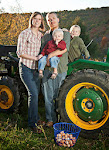This Saturday, I went to the local Grass Grazers Group. It's a pretty neat deal, typically they do pasture walks once every month or so, and if you want to talk about rotational grazing, this is a pretty good group to do it with. Unfortunately, like most agricultural groups around the country, there's not a lot of people in the group that have any color left in their hair. The average age of the group was probably just under 60 years.
Gerald Fry, a grazing/hay only cattle farmer from down in Rose Bud came up to speak to us about selecting good cattle. The run down of what he had to say was showing us how to select masculine bulls and feminine heifers and selecting a proportional cow. We also looked at determining meat quality through things like the thickness of the hide, etc.
.JPG)
This bull was judged a not great male to expand a herd. The hide was tough, his nuts were twisted, etc. The guys up above are measuring him, checking his proportions. It was guessed that he'd have a really poor tenderloin, and the meat would be tough.
.JPG)
This heifer was judge to be a really good, feminine cow. Turns our she was from the best cow in the farmer's herd. It was neat to hear the guys judge a farmer's cow, make guesses about the cow's performance and have the farmer grade their guess.
I've seen this same stuff work miracles breeding productivity back into turkey, laying hens, and meat breeds of chickens that have lapsed into inefficency since they've been largely replaced by modern hybrids. Ironically, a good structured cow gets dinged in the sale barn. Feedlots are in the business of selling supplements and inputs, not efficiency. They don't care if a farmer stays in business or not.
Coincidentally, I was talking to a friend last night who came over to our house, telling her about the workshop. Turns out her dad is a buyer at a sale barn in another part of the state, and he has beautiful, productive cattle, but those aren't the kind of cows he sends to the feedlot.
Have you ever noticed that old black and white pictures of cattle, sheep, etc look completely different than the same breeds today? Back in the day they looked like furry barrels.
Carla and I are looking into getting cattle in the next few years. With the new pastures opening up, we'll have around 20 acres of good pasture in a couple of years. Enough to have a small herd to feed us, and once we get past the learning curve of figuring out what we're doing, we have the option to lease land and build up a small herd. Or we may not get cattle at all. We'll make the choice when we get there.
.JPG) A lot of the people reading this won't really care about tomorrow's college football game, but tomorrow's game here in Fayetteville pits #1 Alabama vs #10 Arkansas, the local school.
A lot of the people reading this won't really care about tomorrow's college football game, but tomorrow's game here in Fayetteville pits #1 Alabama vs #10 Arkansas, the local school..JPG)
.JPG)
.JPG)
.JPG)
.JPG)
.JPG)
.JPG)
.JPG) s
s.JPG)








